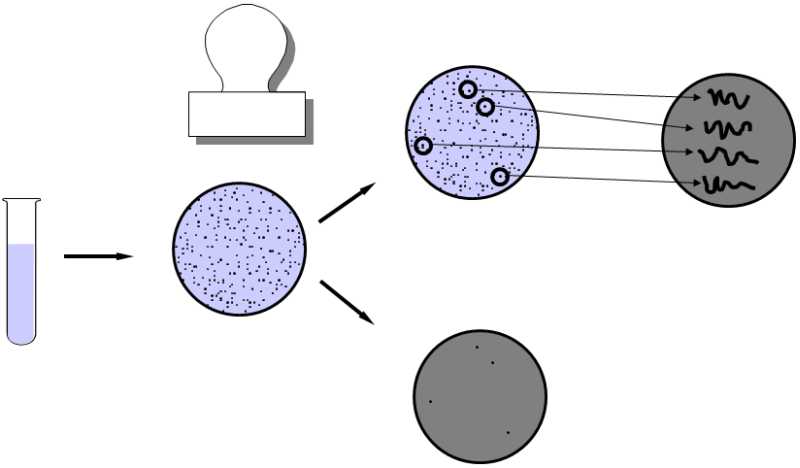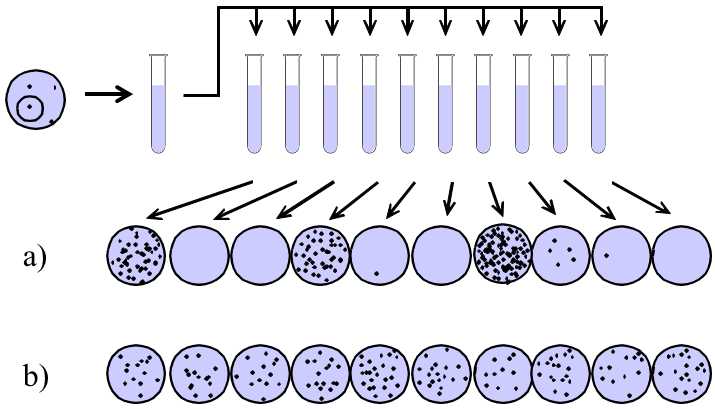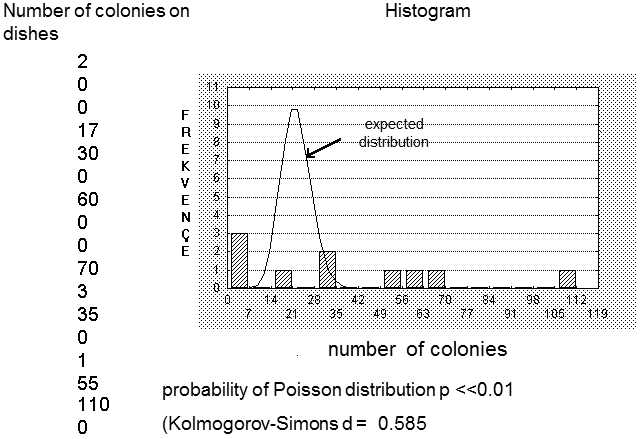III.11 Fluctuation tests show that mutations occur randomly and are not environmentally directed.
As I mentioned above, some species are capable of generating a greater number of mutations under certain, usually stress conditions.This allows them to overcome the unfavourable conditions.Some authors are of the opinion that the organism is capable not only of generating a suitable number of mutations, but that it is also capable of generating just those mutations that allow it to overcome the currently active unfavourable environmental factor.In other words, according to these concepts, organisms are capable of environmentally directed mutations.
The best known experiments that tested this possibility consist in replica plating tests (Ledeberg & Ledeberg 1952)and also various variants of the fluctuation test (Luria & Delbruck 1943).In the replica plating test (Fig. III.6), a bacteria suspension is seeded on a Petri dish and,

Fig. III.6. Replication test. In this test, first a culture of bacteria sensitive to the particular selection agent is spread on a Petri dish without this agent, e.g. without a certain antibiotic. When the individual bacterial colonies grow on the surface of the dish, they are imprinted using a bacteriological stamp onto a Petri dish with an antibiotic and on a Petri dish without the antibiotic (the darker dish in the figure). Once again, all the colonies of bacteria like those on the original dish grow on the dish without the antibiotic; only the colonies of resistant mutants grow on the dish with the antibiotic. As the colonies grow on both dishes in the same positions as on the original dish, it is possible to identify colonies of bacteria that grew on the dish with the antibiotic on the dish without the antibiotic. Bacteria from these colonies, i.e. bacteria that never came into contact with the antibiotic, can be tested for resistance by transferring them using an inoculation loop to the dish with the antibiotic. It was found in the experiments that these bacteria are resistant and thus that the formation of mutations providing the bacteria with resistance does not depend on whether the bacteria were or were not exposed to the action of a particular selection agent.
after small colonies are formed, they are imprinted using a large round stamp on a dish whose agar contains a suitable selection agent (e.g. a certain antiobiotic) and also on a dish without the antibiotic.Only colonies of mutated cells grow in the dish with the antibiotic.In the next phase, samples of the colonies are taken corresponding to the positions of the colonies of mutated cells in the dish without the antibiotic, i.e. samples of bacteria that never came into contact with this antibiotic, and their resistance is tested.If the mutations occurred only as a consequence of the action of the selection agent, the bacteria from these colonies should not be resistant.In contrast, if the mutations occurred randomly, bacteria from the original colonies should be resistant.The results of replica plating tests demonstrated that bacteria on the original dish are already resistant and thus that they mutated randomly.
In the fluctuation tests (Fig. III.7), we also determine whether the mutation providing

Fig. III.7. Fluctuation test. In this test, an inoculum of genetically identical bacteria resistant to a certain selection agent, e.g. to a certain antibiotic, is first prepared. Then this inoculum is used to inoculate a series of test tubes with liquid medium without this antibiotic and the bacteria are left to grow, e.g. for 24 hours. Finally, a sample of the bacteria from each test tube is inoculated on a Petri dish, whose agar substrate contains the studied antibiotic. Only colonies of resistant bacteria grow on the dishes; therefore the number of colonies on the dish corresponds to the number of mutants, i.e. resistant bacteria, that were originally seeded on the Petri dish. Result (a) corresponds to the situation where the bacteria are mutating in the test tube, while result (b) corresponds to the situation where the bacteria start to mutate on the dishes in the presence of the antibiotic.
resistance against a certain toxic agent occurred before addition of the selection agent or after its addition.The experiment can be performed by growing a larger innoculum of genetically identical bacteria from one cell, adding this innoculum in the same amount to a series of test tubes with fresh nutrient medium and leaving the bacteria to further multiply here, e.g., for 24 hours.Then a sample of bacteria from each test tube is seeded on one Petri dish containing an antibiotic to which all the bacteria were sensitive at the beginning of the experiment.After a certain time, e.g., after two days, we count the colonies of resistant bacteria on the individual dishes (unmutated bacteria, i.e. those sensitive to the antibiotic, do not grow on the dishes).If the mutations occurred only as a reaction to the presence of the antibiotic, then there should be approximately the same number of colonies on all the dishes or, to be more exact, the number of colonies should have Poisson distribution (Fig. III.8).If the mutations occurred spontaneously, i.e. before the bacteria came into contact with the

Fig. III.8. Result of the fluctuation test. If the mutation were to occur only in response to the action of the selection agent, i.e. on the Petri dishes, the numbers of the individual colonies on the dishes should have approximately Poisson distribution, i.e. the average number of colonies on the dish should correspond approximately to the variance in the number of colonies per dish. However, in the experiment, the variance of the number of colonies substantially exceeded the average number of colonies on the dishes; no colonies of resistant bacteria grew in a great many places, while hundreds could grow in other places. The relevant tests indicate that the obtained distribution differs from Poisson distribution. This is a result of the fact that mutations mostly occurred during cultivation in the test tubes in the absence of the antibiotic. Thus, the numbers of mutations formed in the individual test tubes have Poisson distribution, but the mutants reproduce exponentially after they are formed in the test tubes. The numbers of colonies on the individual dishes are thus dependent particularly on the time expired between the formation of the particular mutant and the seeding on the plate, i.e. on the time they had for reproduction in the test tube.
antibiotic, the numbers of colonies on the individual dishes should differ substantially, i.e. should substantially fluctuate.This is a result of the fact that a mutation can occur in the test tube prior to seeding on the dish at any moment; the mutant could multiply exponentially in the particular test tube up to the moment of seeding on the dish.If approximately the same number of mutations occurred in each test tube, the resultant numbers of colonies in the dishes would differ according to when the mutations occurred.If the particular mutation occurred just before seeding on the dish, then a single colony is obtained; however, if the same mutation occurred 3 hours prior to seeding then, for a generation time of the bacteria of, e.g., 30 minutes, the particular mutation can appear as the presence of up to 64 colonies on the dish.As the number of colonies on the dishes actually differed substantially in the laboratory experiments, fluctuation tests were considered until recently to be the strongest proof that mutations always occur randomly, spontaneously, and are not environmentally directed, i.e. induced by the presence of an antibiotic.s
